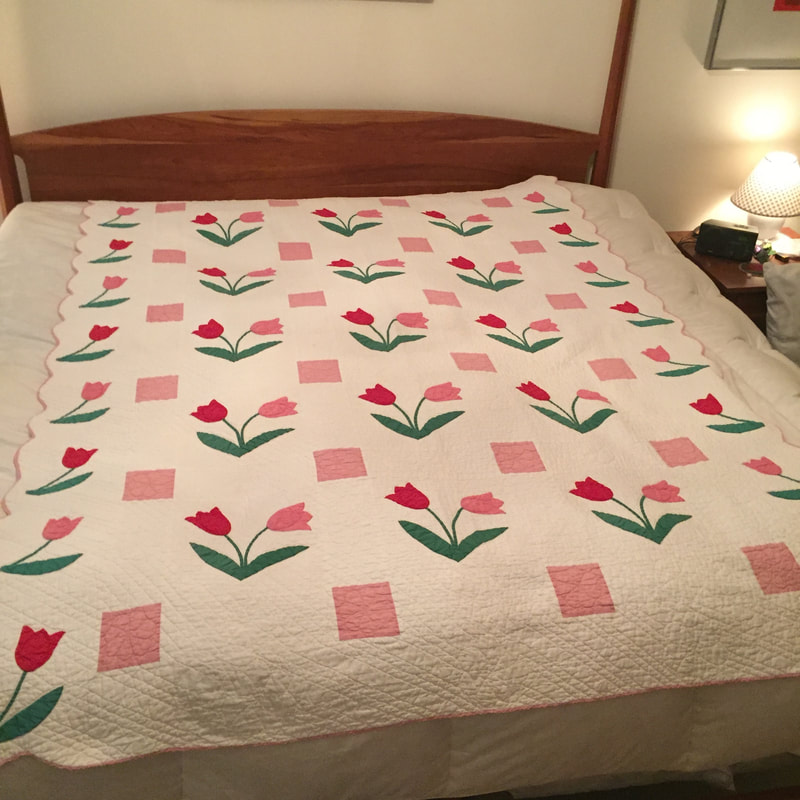Garden Quilts
Formal gardens have long been the inspiration for art ever since the beginnings of this country. The formal gardens of Governor Spotswood, in Williamsburg, Virginia began this trend. These gardens were known for their orderliness and beauty, which was created through the clever use of borders and symmetry to corral nature's beautiful bounty.
Explore with Connie Thompson, these two key elements, borders and symmetry in the design of your own garden quilt.
Borders: Grass often served as a border for colonial flower gardens. But fences, building, walls, hedges, walkways were also used. Likewise, quilters have many options for creating borders: sashing, internal and external borders, swags (borders aren't always straight), and borders built right into the repeating blocks themselves. Borders shouldn't just be an after-thought in quilt design...they should be planned for in the beginning.
Symmetry: We are most familiar with mirror symmetry, but other types of near symmetry help organize diverse elements. Are the flowers in the two quilts above symmetrical? Even if not exhibiting mirror symmetry, a near-symmetry does provide order and organization.
With a PowerPoint presentation that favors pictures over words, Connie will display many examples of the above two concepts. In terms of subject matter, nature provides an infinite choice of subject matter. Borders and symmetry will be two tools you can use to organize this treasure trove of subject matter.
Other topics are covered too: Massed plantings (repetition) versus a specimen (medallion) display; the quilting patterns reflecting nature...leaves, seeds, etc. The trend to lesser organized, wilderness inspired, art quilts is shown. When some quilters see a border, they just see a challenge to drive right through it! Artists love to break down walls.
The program concludes with a trunk show a several antique quilts from the Thompson's collection. Afterwards, feel free to come up, put on a pair of white gloves provided, and take a closer look at these beautiful antique garden quilts.
Call Jim or Connie at 757-903-2635, or email them at rugbyjimthompson@gmail.com for more information, or to schedule this presentation for an upcoming quilting guild meeting.
Explore with Connie Thompson, these two key elements, borders and symmetry in the design of your own garden quilt.
Borders: Grass often served as a border for colonial flower gardens. But fences, building, walls, hedges, walkways were also used. Likewise, quilters have many options for creating borders: sashing, internal and external borders, swags (borders aren't always straight), and borders built right into the repeating blocks themselves. Borders shouldn't just be an after-thought in quilt design...they should be planned for in the beginning.
Symmetry: We are most familiar with mirror symmetry, but other types of near symmetry help organize diverse elements. Are the flowers in the two quilts above symmetrical? Even if not exhibiting mirror symmetry, a near-symmetry does provide order and organization.
With a PowerPoint presentation that favors pictures over words, Connie will display many examples of the above two concepts. In terms of subject matter, nature provides an infinite choice of subject matter. Borders and symmetry will be two tools you can use to organize this treasure trove of subject matter.
Other topics are covered too: Massed plantings (repetition) versus a specimen (medallion) display; the quilting patterns reflecting nature...leaves, seeds, etc. The trend to lesser organized, wilderness inspired, art quilts is shown. When some quilters see a border, they just see a challenge to drive right through it! Artists love to break down walls.
The program concludes with a trunk show a several antique quilts from the Thompson's collection. Afterwards, feel free to come up, put on a pair of white gloves provided, and take a closer look at these beautiful antique garden quilts.
Call Jim or Connie at 757-903-2635, or email them at rugbyjimthompson@gmail.com for more information, or to schedule this presentation for an upcoming quilting guild meeting.

